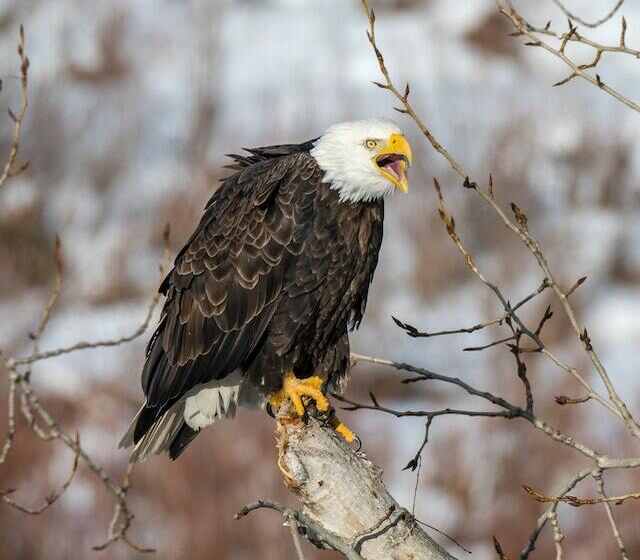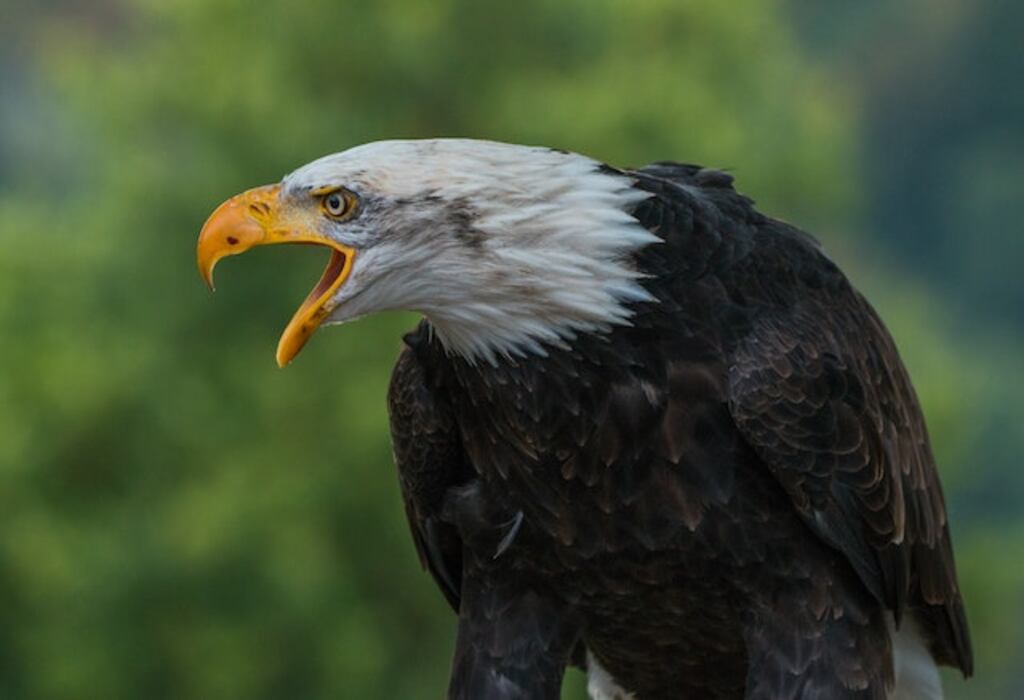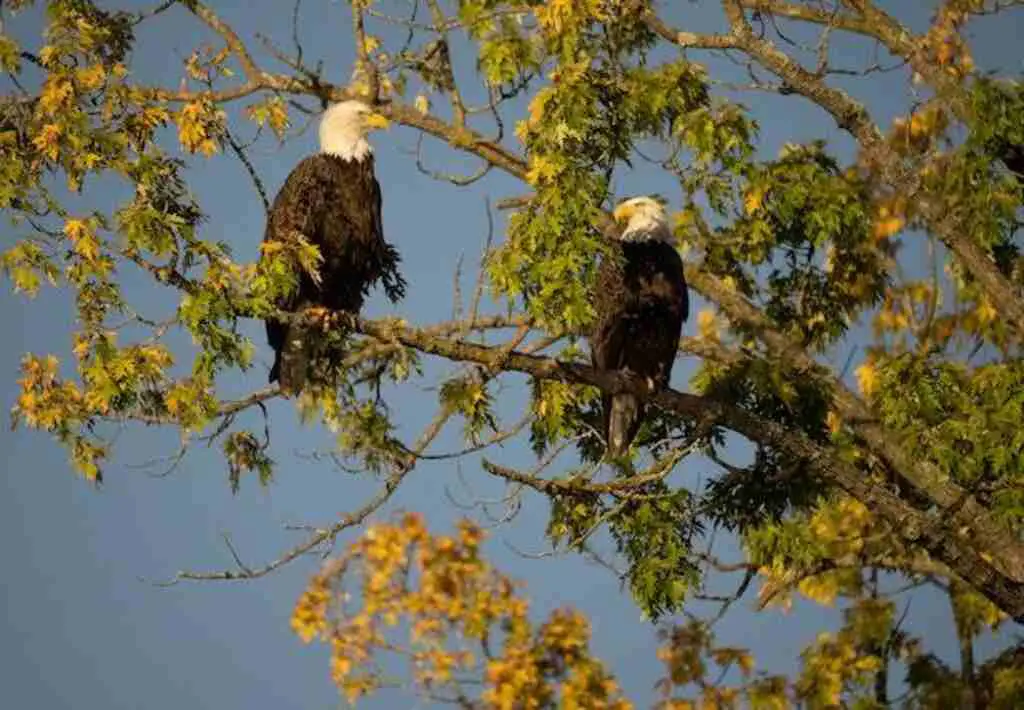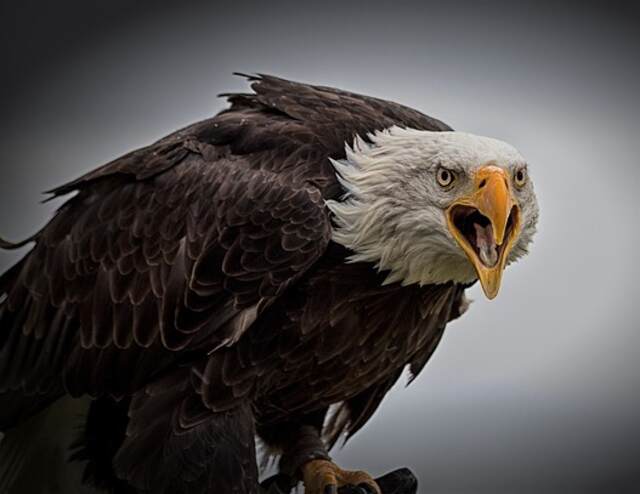How Do Eagles Communicate? Prepare for a captivating journey into the world of our ‘eagle-eyed’ friends, where remarkable vision meets extraordinary communication skills.
These social creatures rely on a complex web of signals to navigate their environment and thrive.
From vocalizations and body language to intimate interactions within their community, eagle communication reveals the intricacies of their lives.
Delve into this awe-inspiring exploration to unravel the secret language of these majestic birds, gaining a newfound appreciation for their vital role in our ecosystem.
Let the captivating symphony of eagle communication unfold before your eyes!
Table of Contents
- 1 Key Takeaways
- 2 How Do Eagles Communicate
- 3 Overview of Eagle Communication
- 4 Different Forms of Eagle Communication
- 5 Importance of Eagle Communication
- 6 Vocalizations
- 7 Behaviors
- 8 Body Language
- 9 Differences in Communication Between Species
- 10 Communication During Hunting
- 11 Eagle Communication and Human Interaction
- 12 Frequently Asked Questions
- 13 Conclusion
- 14 Author
Key Takeaways
- Eagle communication takes many forms, including vocalizations, behaviors, and body language.
- Different forms of eagle communication include calls, screams, postures, visual displays, and visual cues.
- Eagle communication is essential for coordinating hunting and foraging activities, social bonding, and establishing dominance.
- Human activities can disrupt eagle communication and hunting efforts, making conservation efforts crucial for eagle populations.

How Do Eagles Communicate
Eagles communicate through a combination of vocalizations, body language, and visual displays.
Vocalizations include calls, screams, and whistles, while body language involves postures, wing movements, and gestures.
Visual displays, such as soaring and aerial acrobatics, also serve as communication signals.
These mechanisms enable eagles to convey messages to their mates, offspring, and fellow community members, ensuring effective social interactions and successful hunting endeavors.
Overview of Eagle Communication
Eagles communicate with each other through a variety of vocalizations and body language, including calls, screams, and postures, creating a complex system of signals that convey key information about their social behavior and environmental surroundings.
Eagles have different hunting strategies and mating rituals, and they use their unique communication system to coordinate and communicate with their mates and offspring.
For example, during hunting, eagles use different calls to signal their hunting strategies and to coordinate their movements with their mate.
During mating rituals, eagles use postures and vocalizations to communicate their readiness to mate and to attract a mate.
Understanding the different forms of eagle communication is essential to understanding their behavior and social structure.
The next section will explore the different forms of eagle communication in more detail.
Different Forms of Eagle Communication
Various modes of communication exist among the eagle species, including vocalizations, body language, and visual displays.
Eagles use a combination of these communication methods to convey messages to their own species and to other animals in their environment.
Vocalizations may include screeches, screams, and whistles, which are used for territorial signaling and warning other animals of potential danger.
Body language, such as posturing, flapping wings, and puffing up feathers, can convey aggression, submission, or courtship.
Visual displays, such as aerial acrobatics and soaring, are used for territorial signaling and for attracting a mate.
Eagles also use visual cues, such as the position of their head and eyes, to communicate with other eagles and animals.
The importance of eagle communication lies in its ability to establish dominance, defend their territory, and find a mate.

Importance of Eagle Communication
The importance of eagle communication can be discussed in terms of its crucial role in the survival of these birds in the wild.
Effective communication allows eagles to coordinate their hunting and foraging activities, which in turn ensures their access to food and resources.
Additionally, communication also plays a vital role in social bonding among eagles, enabling them to form and maintain relationships that are essential for their long-term survival.
Survival in the Wild
Survival in the wild requires a keen sense of awareness and adaptability to the constantly changing environment. Predator-prey relationships play a significant role in the survival of many species, including eagles.
To survive, eagles have developed various adaptation strategies, such as hunting techniques, sharp vision, and hearing abilities.
Additionally, eagles have a unique ability to adapt to various environmental conditions, including extreme weather conditions and changes in food availability.
These adaptations allow eagles to thrive in the wild and maintain their position at the top of the food chain.
Social bonding is another critical factor in the survival of eagles, as it enables them to work together to hunt, defend territory, and protect their young.
The next section will discuss social bonding in greater detail.
Social Bonding
Social bonding plays a crucial role in the success of eagle communities, allowing for effective communication and cooperation in tasks such as hunting and defending territory.
Eagles establish strong bonds through a variety of bonding rituals, such as mutual preening and aerial displays.
These rituals help to solidify the social hierarchy within the community, allowing each eagle to understand its place and role within the group.
Through social bonding, eagles are able to coordinate their efforts and work together to achieve common goals, ultimately increasing their chance of survival.
However, effective communication is also vital to the success of eagle communities, and will be explored further in the subsequent section about vocalizations.
As creatures that soar high above the ground, eagles are symbolic of freedom, and their social dynamics offer insight into the importance of relationships and cooperation in achieving that freedom.
| Emotional Response | Explanation |
|---|---|
| Freedom | Eagles are often seen as symbols of freedom, as they soar high above the ground and have few natural predators. This table is designed to evoke the idea of freedom and encourage the audience to think about how social bonding plays a role in achieving it. |
Vocalizations
Vocalizations vary among different eagle species and may include screeches, screams, whistles, and chirps. These vocalization types serve different purposes, including communicating with other eagles, warning off predators, and attracting mates.
Mating calls are an important aspect of eagle vocalizations and are used by both sexes to attract a mate during the breeding season.
Eagle vocalizations are also used to establish territorial boundaries and reinforce social bonds.
While some species of eagles are more vocal than others, all eagles use vocalizations as an important means of communication.
Moving on to behaviors, eagles exhibit a wide range of behaviors that are essential to their survival in the wild.

Behaviors
While vocalizations play a significant role in eagle communication, their behaviors also contribute to their ability to convey messages.
Eagles use a variety of behaviors to communicate with one another, including territorial disputes and courtship rituals.
These behaviors are often accompanied by specific body language and postures that have specific meanings.
For example, when an eagle is preparing to defend its territory, it may puff up its chest, spread its wings, and make aggressive movements towards the intruder.
On the other hand, during courtship rituals, eagles may engage in aerial displays, such as flying in tandem or performing acrobatic maneuvers.
These behaviors and body language are crucial in eagle communication, as they provide important cues to other eagles about their intentions and emotions.
Moving forward, we will explore how eagles use their body language to communicate with one another.
Body Language
Through their postures and movements, eagles are able to convey important messages and emotions to other eagles, contributing to their complex system of communication.
Non-verbal cues, such as wing flapping, head tilting, and beak snapping, are used to signal aggression, submission, or attraction.
Additionally, territorial displays, such as soaring high in the sky or perching on a high branch, communicate ownership and dominance over a particular area.
Body language is particularly important in communication between eagles, as they often hunt and mate in pairs or small groups.
Understanding these non-verbal cues is essential for eagles to navigate their social interactions and maintain their hierarchy within the group.
However, as we will explore in the next section, these communication methods can vary greatly between different species of birds.
Differences in Communication Between Species
Bird species demonstrate unique communication patterns that are symbolized by their distinctive physical features and behaviors.
These communication patterns are shaped by a variety of factors, such as habitat, social structure, and mating behaviors.
Some bird species rely heavily on visual communication, using a range of displays and signals to convey information to other members of their species.
For example, male birds may use visual displays to attract potential mates or to assert dominance over other males.
Other bird species rely more on olfactory communication, using chemical signals to communicate with other birds.
This type of communication can be particularly important for birds that live in dense forests or other environments where visual communication may be difficult.
Overall, the differences in communication between bird species are fascinating and varied, reflecting the complex ways in which they have evolved to survive and thrive in their unique environments.
As we move on to the next section about communication during hunting, we will explore how birds use their communication skills to work together and achieve their goals.

Communication During Hunting
Communication during hunting is a crucial aspect of avian behavior, and eagles are no exception. Hunting strategies and prey selection require the use of various vocalizations and body language to coordinate hunting efforts.
Eagles communicate through a wide range of calls, including screeches, whistles, and chirps, which convey different messages to their hunting partners.
They also use body language to signal their intent and to coordinate their movements during the hunt.
For example, eagles may use head bobs, wing flaps, and tail flicks to signal their intention to attack or to change their direction.
The success of eagle hunting efforts depends on their ability to communicate effectively with each other.
The use of communication allows them to coordinate their movements, avoid competing with each other, and increase their chances of catching prey.
As we move into the subsequent section about eagle communication and human interaction, it is important to note that human activities can disrupt eagle communication and hunting efforts, highlighting the need for conservation efforts to protect these majestic birds.
Eagle Communication and Human Interaction
Eagle conservation efforts have become increasingly important due to the decline in eagle populations caused by human interference.
Human activities such as habitat destruction, hunting, and pollution have had a significant impact on eagle populations.
Consequently, there is a need for more coordinated conservation efforts to protect these magnificent birds and prevent their extinction.
Eagle Conservation Efforts
Efforts to conserve eagles have become increasingly important due to the decline in their population caused by habitat loss and human disturbance.
Collaborative initiatives and community involvement have played a crucial role in the conservation of eagles.
Governments, NGOs, and local communities have come together to protect eagle habitats, monitor eagle populations, and reduce human interference in their habitats.
Some of the measures taken include the establishment of protected areas, the enforcement of laws against hunting and trading of eagles, and the promotion of sustainable land use practices.
Despite these efforts, eagles continue to face threats from human activities such as development, logging, and mining.
Therefore, it is important to continue to monitor eagle populations and their habitats to ensure their survival.
Human interference and its impact on eagles will be discussed in the subsequent section.
Human Interference and Its Impact
Human activities such as development, logging, and mining have significantly impacted the habitats and populations of eagles.
These interventions often lead to the destruction of natural habitats, reducing the availability of prey and nesting sites for the eagles.
As a result, the eagle population is declining at an alarming rate. The table below highlights the impact of human intervention on eagle populations in different regions of the world.
It shows that habitat loss is the primary reason for the decline in populations.
In order to prevent the extinction of these majestic birds, it is essential to take immediate action to protect their habitats and reduce human intervention.
This can be achieved through the implementation of policies that encourage sustainable development and the protection of natural habitats.
It is also important to raise awareness about the importance of eagles in the ecosystem and the need to preserve their habitats for future generations.
| Region | Number of Eagle Species | Status | Threats |
|---|---|---|---|
| North America | 8 | Endangered | Habitat loss, pollution, hunting |
| Europe | 2 | Vulnerable | Habitat loss, illegal hunting |
| Africa | 7 | Endangered | Habitat loss, hunting, poisoning |
| Asia | 12 | Endangered | Habitat loss, hunting, pollution |
| Australia | 3 | Endangered | Habitat loss, hunting, pollution |
Frequently Asked Questions
How do eagles mate?
Eagle courtship rituals involve aerial displays, synchronized flights, and mutual preening. Reproductive behavior includes the transfer of sperm via cloacal kiss and the incubation of eggs. These behaviors are crucial for the continuation of the species.
What is the lifespan of an eagle?
The lifespan of an eagle varies by species and environmental factors. Bald eagles can live up to 20-30 years in the wild, while golden eagles can live up to 30-40 years. Aging eagles may experience physical decline and decreased reproductive success.
Do eagles have a sense of smell?
Eagles have a keen sense of smell, allowing them to detect prey from long distances. They use this olfactory sense in combination with their exceptional vision and hunting techniques to catch their prey, making them formidable hunters.
How do eagles choose their nesting sites?
Eagle nesting and habitat selection are complex processes that involve a multitude of factors such as prey availability, predator presence, weather patterns, and topography. Eagles meticulously choose their nesting sites based on these criteria to ensure the survival of their offspring.
What is the role of eagles in their ecosystem?
Eagles play a crucial role in their ecosystem as both predator and prey. They help maintain the balance of their habitat by controlling populations of other animals and contributing to nutrient cycling. This highlights the importance of their conservation for the health of the ecosystem.
Conclusion
Eagles are magnificent creatures that have a complex communication system. They communicate through various means such as vocalizations, behaviors, and body language.
Their communication is crucial in various aspects of their lives such as hunting, mating, and social interactions.
The difference in communication between species of eagles is also fascinating to study.
The Bald Eagle has a unique vocalization that distinguishes it from other species, while the Golden Eagle uses body language to communicate.
Observing the communication of eagles during hunting is also intriguing as they work together to catch their prey.
Eagle communication and interaction with humans is also an area of study. Human interference can disrupt their communication and social interactions, affecting their survival.
Overall, studying eagle communication provides a deeper understanding of these majestic creatures and their complex social lives.
The communication system of eagles is a beautiful reminder of the intricacies of nature and the importance of preserving it.




